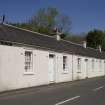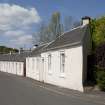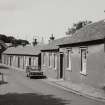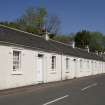Bute, Rothesay, 4 John Street
Terraced House (19th Century), Workers Cottage (19th Century)
Site Name Bute, Rothesay, 4 John Street
Classification Terraced House (19th Century), Workers Cottage (19th Century)
Canmore ID 251985
Site Number NS06SE 296
NGR NS 08686 64500
Datum OSGB36 - NGR
Permalink http://canmore.org.uk/site/251985
- Council Argyll And Bute
- Parish Rothesay
- Former Region Strathclyde
- Former District Argyll And Bute
- Former County Buteshire
Characterisation (29 July 2010)
This site falls within the Industrial Rothesay Area of Townscape Character which was defined as part of the Rothesay Urban Survey Project, 2010. The text below relates to the whole area.
Historical Development and Topography
This area has historically been the centre of any industrial activities in Rothesay, and continues to be so today. The earliest industries set up in this area took advantage of the water supply from the Water of Fad, which eventually became Mill Lade. In 1779, Scotland’s second cotton mill was established in Rothesay by James Kenyon – the first was built in Penicuik in 1778 – and a number of smaller mills were subsequently established here. As a result, this area became a focus for industry inland, away from existing, well-established industries such as boat building and fishing.
Housing for the millworkers naturally grew up close to the mills that had set up around this area. In particular, Colmshill Place and Street still have the planned terraced houses built sometime between 1780 and 1825 for some of the millworkers, as does John Street where there is a short terrace of single-storeyed houses built in 1805 by the Cotton Mill Society.
During the 19th century, the fortunes of the textile industry in Rothesay fluctuated greatly. In 1855, there were five mills in the town, but by the 1880s all of them had closed. The largest mill was converted to an orphanage in the late 19th century, before returning to textile use when Bute Fabrics took up tweed manufacture in the 20th century.
The nature of industry as a whole in the area changed with saw mills, market gardens and nurseries becoming prevalent in the outer reaches of the town. The Corporation Gas Works were established in the north of the area in the 1840s on the site in Colmshill Street now occupied by the Byzantine-style St Andrew’s Roman Catholic Church and Priest House by Reginald Francis Joseph Fairlie in 1922-3. The gas works subsequently moved to a site on the boundary with Townhead Area of Townscape Character sometime between 1897 and 1915.
There was an associated boom in house building in the 19th century, as Rothesay’s population grew with workers for the industries coming to the town, as well as as a result of the tourism boom. Ordnance Survey mapping shows that the resulting need for accommodation for visitors and residents alike saw expansion along Barone Road in the form of semi-detached villas, while tenemental properties grew up nearer the town centre in Russell Street, Mill Street, Columshill Street and Ladeside Street. A small group of five much later ‘Homes for Heroes’ was built in 1951 by the Scottish Veterans’ Garden Housing Society Ltd in the grounds of Bute Fabrics off Barone Road, and these still offer accommodation to disabled ex-service, merchant marine, police and fire brigade personnel today.
Overall, Industrial Rothesay Area of Townscape Character has a high density of population, with relatively small plot sizes for residential properties, but large plots for industrial premises. There are small pockets of planned development, but on the whole, the area has developed in an ad hoc manner, particularly in the southern half where the majority of the industrial premises are located. There has been much redevelopment in the area as industries dwindled and were replaced, such as the garage on the site of former mills in Mill Street. The Scots-Baronial tenements on Russell Street and Mill Street replaced earlier buildings on the site of Old Vennel. These tenements were commissioned by Thomas Russell, a director of the Glasgow iron foundry Walter MacFarlane & Co, who was Rothesay’s Member of Parliament for a mere three months in 1880, and lived in Ascog. Russell oversaw many improvement schemes for the town during his lifetime, and these tenements, dated 1877, may have been designed by architect James Hamilton, who lived in Rothesay with his son, John.
There has been more recent 20th century infilling and redevelopment in Mill Street, Columshill Street and Bridgend Street. There is also continuing industrial usage at the late 20th century Bute Business Park on the southern edge of the main industrial zone.
Present Character
This area of Rothesay still retains its industrial character today, despite the many changes there have been here over the centuries. The large late 18th/early 19th century cotton mill building in the centre of the area remains, albeit in a heavily altered form as a result of its expansion and changes of use over its lifetime. Early to late 19th century millworkers’ housing in Colmshill Street and Place remain as good survivals of their type, having been sympathetically restored by the Bute Housing Association (now Fyne Homes) in 1983. Likewise the short terrace of 1805 cottages in John Street are good examples of their type, with a much later (c.1935) end of terrace (No 5) presenting a fine imitation of the style.
While industry is the main function of the area, it also serves as a high-density residential zone, particularly in the northern and southern edges. There is a wide range of building types in the area: two-storeyed terraced millworkers’ housing in the Colmshill area dating from the late 18th to mid-19th century; single-storeyed millworkers’ cottages in John Street from 1805; late 19th century Scots Baronial-style tenements in Russell and Mill Street; plainer 19th century tenements on Colmshill and Ladeside Streets; and semi-detached early 20th century Arts & Crafts housing on the southern edge of the area on Barone Road and Auchnacloich Road. A fine example of the architect Reginald Francis Joseph Fairlie’s work survives in St Andrews Roman Catholic Church, built in a Byzantine style in 1922-3, along with the associated Presbytery on Colmshill Street.
The overall form of area continues to appear fairly random, with very few planned or regular street layouts in the area which gives the area an organic form.
Information from RCAHMS (LK), 29th July 2010
















